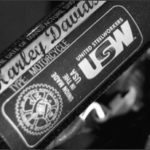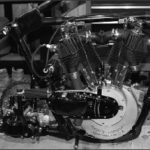What does “Made in the USA” mean these days? I know what it used to mean when it was obvious. Now the definition is nebulous and nuanced to the point you really have to think about it. Subject to interpretation—as they say. It wasn’t always.
Roll the clock back about 45 years to the mid-’60s. There were motorcycles sold here at the time that came from Italy, England, Japan, Germany and America. Back then, “made” anywhere meant that everything on the machine came from the country of origin. English motorcycles had electrics manufactured by Lucas, carburetors by Amal, shocks by Girling and so on. German bikes had Bosch electrics, Bing carburetors, and other components all built in the same country as the machines. Italians used Marelli electrical stuff, Dell’Orto carbs… etc. The Japanese (then as now, ironically) used parts that were all of Japanese origin. Meanwhile, Harley, even back then, had to scramble to source everything in the U.S. The simple example is carburetors. Linkert had been the purveyor to The Motor Co. for quite a long while, then suddenly H-D didn’t do enough volume (less than 20,000 motorcycles a year) to keep that supplier happy (or vice-versa, depending on who’s telling the story)—so the factory had to resort to (no kidding) snowmobile carbs made by Tillotson. Not a perfect solution, but then as now, H-D did what it had to do to survive. What made it all so simple then was that each nation had resources for these components (like ’em or not) and the machines were not just assembled, but completely manufactured (and designed) in their respective countries of origin.
There’s a certain comfort in that unambiguous way of doing things. There’s also a strong sense of identity that goes along with the character of each machine, resulting from their “nationality.” German machines had pretty long “legs” and were also long on reliability very early on, because autobahns existed there a generation before we had freeways. High-speed cross-country road trips were reality there, and the motorcycles were transportation rather than hobby horses, so they had to suit the nature of their primary market. Italian and British motorcycles had a very different environment to deal with, mostly crooked oxcart trails and relatively short distances to travel (at moderate velocities) and meant agile and easy to (frequently) maintain machines took precedence—also in surroundings that favored motorcycles as transportation more than recreation. The motorcycles made in the USA were practically 180 degrees out from those priorities. Vast distances over all kinds of roads and terrain required rugged durability and equally vast under-stressed engine sizes to suit the needs of enthusiasts who rode for the challenge and the fun, rather than to get back and forth routinely. The island nation of Japan really never needed much more than mopeds for their domestic market, but thanks to Soichiro Honda’s vision of global conquest, they never intended “domestic” to be the primary market for their machines. Practically from day one, the Asian eye was on a world market, for which they would gladly design motorcycles that could not even be sold in the home country. That notion, more than anything, was the game changer!
Truly—other manufacturers in other nations didn’t really care. While the British, on one hand, needed to “export or die” (because of the shambles that nation was in after the war), they therefore could and did sell machines here in what would now be considered small volumes—with bigger, more high-strung versions of the engines they already used at home. That turned out to be a dead end when those engines suddenly became shaky and unreliable, after Americans hammered ’em like Harleys. The Italians, on the other hand, really never gave a damn if Americans bought their bikes or not—they could sell enough at home to get by and that was fine. The Germans kinda arrogantly waited for us to discover the virtues they valued, over time and with no big push. Wasn’t really until the ’70s that BMW decided for sure to not just stay in the motorcycle business but to compete for the first time. (Probably because they were paying attention to two things: the way the market in the U.S was exponentially expanding and that the Japanese were responsible.) The Motor Company was awash in its own issues at the time, as has been well documented elsewhere. For our purpose, it’s enough to say that the basics were still viable but the execution was lagging… badly!
Who really knows when (or why) the idea came to some bright soul that you could actually use parts made elsewhere to build motorcycles? Probably was Harley after all, since as early as 1973 the factory was putting Kayaba forks on Sportsters and by 1976 Keihin carbs were on every bike they built. (This—mind you—while the British were still around and still 100 percent made in England, but kaput just a few years later.) Again we see The Motor Company doing what it had to do. Today, there are only two motorcycle manufacturing nations who can completely design and assemble their products from parts they alone make. Yet, even Germany and Japan most likely won’t be able to keep that up much longer with China, Thailand, and other countries like them getting into what is now a very competitive worldwide game. Yet, knowing where the bits and pieces come from can either be confounding or illuminating in our exercise of defining what “Made in the USA” means today. To show you what I mean—let’s use an illustration from the car world, shall we?
What kind of car or truck do you drive? Camry, Maxima, Accord, Mustang, PT Cruiser, Camaro—or perhaps there’s an R-class Mercedes station wagon in your garage? Well, if they are 2010 models, it turns out, thanks to the American Automobile Labeling Act you can at least find out what percentage of your car is made in the USA. In the order listed, that would be 75%, 55%, 75%, 60%, 40%, 60% and 62% respectively. Does it surprise you at all that technically there’s a higher American “content” in a Camry or Accord than in a Mustang or Camaro? Let’s try some trucks in ascending order—namely—Ford F-series (55%), Chevy Silverado (65%), Nissan Titan (65%), Honda Ridgeline (70%) and Toyota Tundra (80%)! So—how crazy is it that the most American of that all-American vehicle, the full-sized friggin’ pickup, is a Toyota? At least by percentage of “Canadian/American content” it is. However, you have to wonder if “content,” whether measured by a parts list of items or pounds of material on scales, is the best working definition (or even guideline) for determining whether a Toyota is American and a Ford is not… don’cha?
I mean, by that “official” definition, sadly not applied to the motorcycle industry, Harleys are still very much made in the USA, since supposedly they are 94 percent American by the percentage-of-content yardstick. Well, as they come off the assembly line anyway, I’m told.
Trouble is—that is not a very satisfying way to look at it, compared to some others that come to mind. For one thing, it seems to me that well-made should outrank where made—every time. Who, besides besotted, myopic pseudo-patriots, cares if the parts come from the four corners of the earth, as long as they wind up in some small point of perfection in the universe known as “my motorcycle?” Harley riders, more than most, should appreciate that the quality (and qualities) of a finished custom-made “personal” machine, depends on the choice of parts used. If German tires, Japanese electrics and Yankee ingenuity are what it takes to come out with Swiss-watch precision and Italian flair in a bike I build as an American expression of my individuality, then so be it!
Which leads to another, possibly better, way to decide if something is made in the USA: simply whether or not it was, in fact, made here by Americans. Content, as such, means no more than intent, after all. Whether you’re a fan of labor unions or not, there’s a skill set that’s obvious to anyone who’s ever toured the factory’s Capitol Drive plant (or likely even the Honda plant in Ohio, while it was operational) which positively shouts “well-made!” It’s also worth noting that back in the day, Harleys were such a maze of shims and spacers it took real skill to build them right. Know-how counts, which AMF found out the hard way, disastrously ramping up production in the ’70s without enough “old-timers” who knew how. Where I’m drifting with this is towards the notion that good men build Harleys right here in the USA. Therefore, these machines are absolutely made in the USA!
I suspect with machines, as with people, there’s something of a birthright in effect here. Maybe instead of “made” we should substitute “born” in the phrase—and allow that any machine that is possessed of intuitively American characteristics—is American—no matter the mixed parentage of parts and engineering. “Assembled” in the USA doesn’t mean exactly the same thing, since (for instance) a moped, no matter where it’s built, really just doesn’t have the necessary “native” DNA. Does this make sense to you?
In the end, the USA has always been a melting pot of individualism, rather then a haven for blue-blooded aristocrats. Maybe it’s more about the mental than the metal, in many ways, yet it seems obvious to me that Harley-Davidson motorcycles could never have sprung forth from anywhere but right here in America. In pursuit of a machine that suits the psyche of an American motorcyclist, that might mean a lot of different things to a lot of different riders, but I submit, no matter how you look at it, Harleys could never be “made” anywhere else!





















